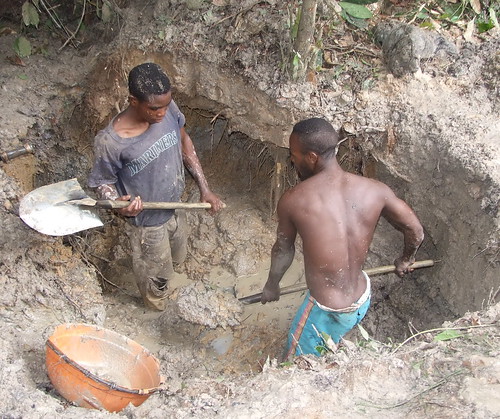Diamonds are a desirable, highly economic, and extreme form of
carbon. The can only formed under intense heat and pressure deep within the
Earth; the upper mantle. But if so how do they get brought up to the surface
for us to mine them? The answer is kimberlite pipes, the hottest and deepest
known rock found on Earth, which periodically erupted through the crust when
the Earth was younger and much hotter than it is today. An excellent animation of how this occurs can be
found on the 'How stuff works' website.
By looking for kimberlite rocks (which have a slightly blue hue)
veins containing diamonds can be found. One such place abundant in diamonds is
Akwatia: Ghana’s biggest mining town. It used to contain predominantly large-scale
mines, but an exponential trend to small and artisanal mines has prevailed in
recent years, as total mining has decreased. This is because these small mines
generally set up on the sites that larger companies have already mined, meaning
their only option is to scavenge lower carat diamonds.
 |
| Graph illustrating the huge increase in small and medium sized mines, compared to large GCD (Ghana Consolidated Diamonds Ltd) owned mines (Yelpaala and Ali, 2005) |
Yelpaala and Ali (2005) produced a paper looking at the effects of
mining in Akwatia. Compared to the predominantly mined commodity in Ghana,
gold, diamonds pose relatively little harm, as the chemical processing involved
cyanide and mercury is not required. However, as artisanal and illegal mines
grow in the numbers other sources of risk to human health and the environment
will rise (a UN study in 2000 estimated that 50,000-80,000 people were engaged
in illegal mining in Ghana).
In the process of mining for diamonds, pits must be excavated and
then the removed material sifted through for the crystals. GCD (one of the
major mining companies in Akwaitia) does this at just 30 to 60% efficiency
(GCD, 2002), creating a huge amount of waste and unnecessary environmental
disruption.
 |
| Men digging a small-scale mine pit |
In digging the pits and then refilling them with the waste a great
deal of land degradation occurs. Although GCD re-vegetate some of their sites,
their small budget doesn’t allow for much. This leads to a loss of plant biodiversity,
many of which are medicinal plants relied upon by the local people,
particularly in the illegal mining sites where no attempt at protecting the
environment is imposed.
When pits are left unfilled they pose human risks; both from a
safety aspect of locals falling into them and injuring themselves, and because
they fill with water and subsequently become mosquito breeding grounds. For a
country with a serious malaria problem that is a dangerous consequence.
However, GCD and other companies simply do not have the money to be able to
fill all the pits.
To move forward, as is the case in all developing countries, a
balance between economic growth and environmental and human impacts clearly
needs to be achieved. Sadly there does not seem to be an easy answer as to how
this can be done.

No comments:
Post a Comment